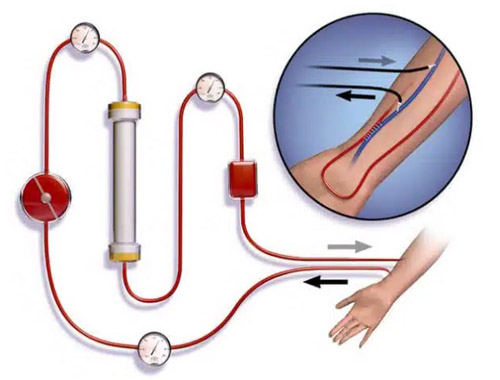Uremia, Renal failure on dialysis

Published: 18 Jun 2025
ICD9: 586 ICD10: N19 ICD11: GB6Z
Let's break down "Uremia, Renal failure on dialysis":
![]() Renal Failure (also known as Kidney Failure or End-Stage Renal Disease - ESRD): This means the kidneys are no longer able to effectively filter waste products and excess fluid from the blood.
Renal Failure (also known as Kidney Failure or End-Stage Renal Disease - ESRD): This means the kidneys are no longer able to effectively filter waste products and excess fluid from the blood.
The kidneys perform vital functions, including:![]()

![]() Filtering waste and toxins from the blood.
Filtering waste and toxins from the blood.![]()

![]() Regulating fluid balance.
Regulating fluid balance.![]()

![]() Controlling blood pressure.
Controlling blood pressure.![]()

![]() Producing hormones.
Producing hormones.![]()

![]() Maintaining electrolyte balance (sodium, potassium, calcium, etc.).
Maintaining electrolyte balance (sodium, potassium, calcium, etc.).![]()

![]() Activating vitamin D for bone health.
Activating vitamin D for bone health.
When the kidneys fail, these functions are severely compromised, leading to a buildup of toxins and fluids in the body.
![]() Uremia: This is a specific condition that arises as a *result* of kidney failure. It refers to the clinical syndrome or collection of symptoms and signs caused by the accumulation of urea and other nitrogenous waste products in the blood when the kidneys are not functioning properly. Essentially, it's the toxic state caused by kidney failure. Symptoms can include:
Uremia: This is a specific condition that arises as a *result* of kidney failure. It refers to the clinical syndrome or collection of symptoms and signs caused by the accumulation of urea and other nitrogenous waste products in the blood when the kidneys are not functioning properly. Essentially, it's the toxic state caused by kidney failure. Symptoms can include:![]()

![]() Fatigue and weakness
Fatigue and weakness![]()

![]() Loss of appetite, nausea, and vomiting
Loss of appetite, nausea, and vomiting![]()

![]() Metallic taste in the mouth
Metallic taste in the mouth![]()

![]() Muscle cramps and twitching
Muscle cramps and twitching![]()

![]() Itching
Itching![]()

![]() Mental confusion
Mental confusion![]()

![]() Swelling (edema)
Swelling (edema)![]()

![]() High blood pressure
High blood pressure![]()

![]() Shortness of breath
Shortness of breath
![]() On Dialysis: Dialysis is a life-sustaining treatment that artificially filters the blood when the kidneys can no longer do so. It removes waste products, excess fluid, and corrects electrolyte imbalances. There are two main types:
On Dialysis: Dialysis is a life-sustaining treatment that artificially filters the blood when the kidneys can no longer do so. It removes waste products, excess fluid, and corrects electrolyte imbalances. There are two main types:![]()

![]() Hemodialysis: Blood is pumped out of the body, passed through a dialysis machine (artificial kidney) to filter it, and then returned to the body. Typically done several times a week at a dialysis center, or sometimes at home.
Hemodialysis: Blood is pumped out of the body, passed through a dialysis machine (artificial kidney) to filter it, and then returned to the body. Typically done several times a week at a dialysis center, or sometimes at home.![]()

![]() Peritoneal Dialysis: A catheter is surgically implanted in the abdomen. A special solution (dialysate) is infused into the abdominal cavity, where it absorbs waste products and excess fluid from the blood through the peritoneum (the lining of the abdominal cavity). The fluid is then drained out. This can be done at home, often overnight.
Peritoneal Dialysis: A catheter is surgically implanted in the abdomen. A special solution (dialysate) is infused into the abdominal cavity, where it absorbs waste products and excess fluid from the blood through the peritoneum (the lining of the abdominal cavity). The fluid is then drained out. This can be done at home, often overnight.
Therefore, "Uremia, Renal Failure on Dialysis" describes a person whose kidneys have failed to the point where they are experiencing the toxic effects of waste buildup in their blood (uremia) and are receiving dialysis treatment to compensate for the lost kidney function.
In simpler terms: The person's kidneys have stopped working properly, they have a dangerous buildup of waste in their blood, and they are being kept alive by dialysis.
Important Considerations:
![]() Chronic vs. Acute: Renal failure can be either acute (sudden onset) or chronic (gradual progression over time). The term "on dialysis" often implies chronic renal failure (ESRD) because acute kidney failure may be temporary and reversible.
Chronic vs. Acute: Renal failure can be either acute (sudden onset) or chronic (gradual progression over time). The term "on dialysis" often implies chronic renal failure (ESRD) because acute kidney failure may be temporary and reversible.
![]() Underlying Causes: Kidney failure can result from various conditions, including diabetes, high blood pressure, glomerulonephritis (inflammation of the kidney's filtering units), polycystic kidney disease, and others.
Underlying Causes: Kidney failure can result from various conditions, including diabetes, high blood pressure, glomerulonephritis (inflammation of the kidney's filtering units), polycystic kidney disease, and others.
![]() Complications: Uremia and renal failure can lead to many complications, including anemia, bone disease, heart problems, nerve damage, and increased susceptibility to infections.
Complications: Uremia and renal failure can lead to many complications, including anemia, bone disease, heart problems, nerve damage, and increased susceptibility to infections.
![]() Kidney Transplant: Dialysis is a treatment to manage kidney failure. A kidney transplant is a potential cure.
Kidney Transplant: Dialysis is a treatment to manage kidney failure. A kidney transplant is a potential cure.
It's essential to consult with a healthcare professional for accurate diagnosis and management of renal failure and uremia.